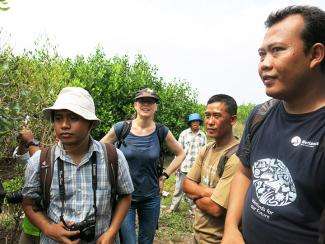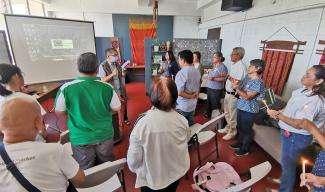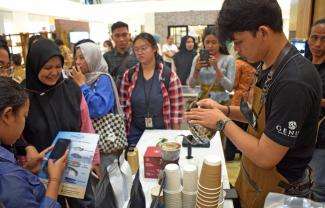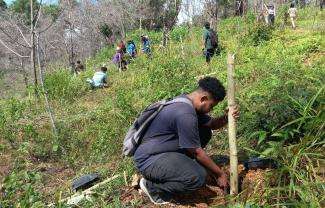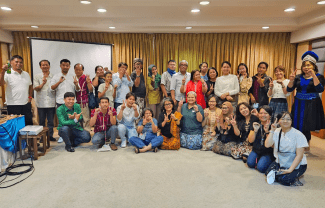The series of partner meetings Ecosystem Alliance (EA) Indonesia (6-9 June 2015) in Jakarta was closed with a field trip to the coast of Banten, on Wednesday (10/6). This location is a site alliance ecosystem members Wetland International Indonesia Programme (WIIP). By bus participants departed from Jakarta and traveled 2.5 hours to arrive at Sawah Luhur Village, Subdistrict Kaseman, Serang City, Banten Province.
"In our site we will see the Sylvo-fishery ponds, integration between aquaculture and forestry activities. The milkfish aquaculture fisheries and forestry it by planting mangrove, "said Iwan Tri Cahyo" Yoyo "Wibisono.
15 minutes from the Serang City, Sawah Luhur Village including Banten coastal areas which troubled by abrasion. The transformation of mangroves to shrimp farms in the 1970s make a major impact on vegetation conditions change, ecology, hydrology and economics community. Since 2009 attempt repairs done, besides mangrove planted around the pond, mangroves also grow on beaches that had been trapped mud to create a new habitat with a semi-hybrid concept engineering.
in cooperation with Indonesia Wetlands Foundation (YLBI) and Pulau Dua Coastal Nature Lovers Group (KPAPPD), WIIP begin a rehabilitation program by planting mangrove coastal dike-dike embankment behind Pulau Dua Nature Reserve and the buffer zone of Pulau Dua Nature Reserve (CAPD ), Sawah Luhur Village.
"We initially worked with 10 members of the group KPAPPD. This Gated formerly displaced, since the pond is planted mangrove members of the group can also harvest wild shrimp come by itself, "said Urip Triyanto, accompanying a group of WIIP.
The local community is involved through a mechanism where people do aquaculture, they can catch shrimp and fish in a pond that is hired by WIIP, but it is obliged to plant and take care of mangrove. Mangrove planted in the pond dike will strengthen the building ponds, provide shade, improve their livelihoods, and help mitigate and to adapt to the impacts of climate change.
Pattern of Sylvo-fishery ponds, in the future can be made the object of environmental education, eco tourism and fishing as towing to prevent people entering the area of the nature reserve Pulau Dua.
Currently about 160,000 mangrove have been planted in 20 hectares of ponds that formerly abandoned, and now public can harvest shrimp and fish were adequate.
"Since mangrove and fishponds planted, group members are already enjoying the results. The result milkfish, shrimp and the results of Eco Tourism with fishing, "said Udin, chairman KPAPPD.
To prevent abrasion of the north coast of Pulau Dua Nature Reserve, WIIP conducting trapped mud by using fishing nets and twigs former plant, further mud trapped expected overgrown mangrove natural (semi-hybrid concept engineering).
